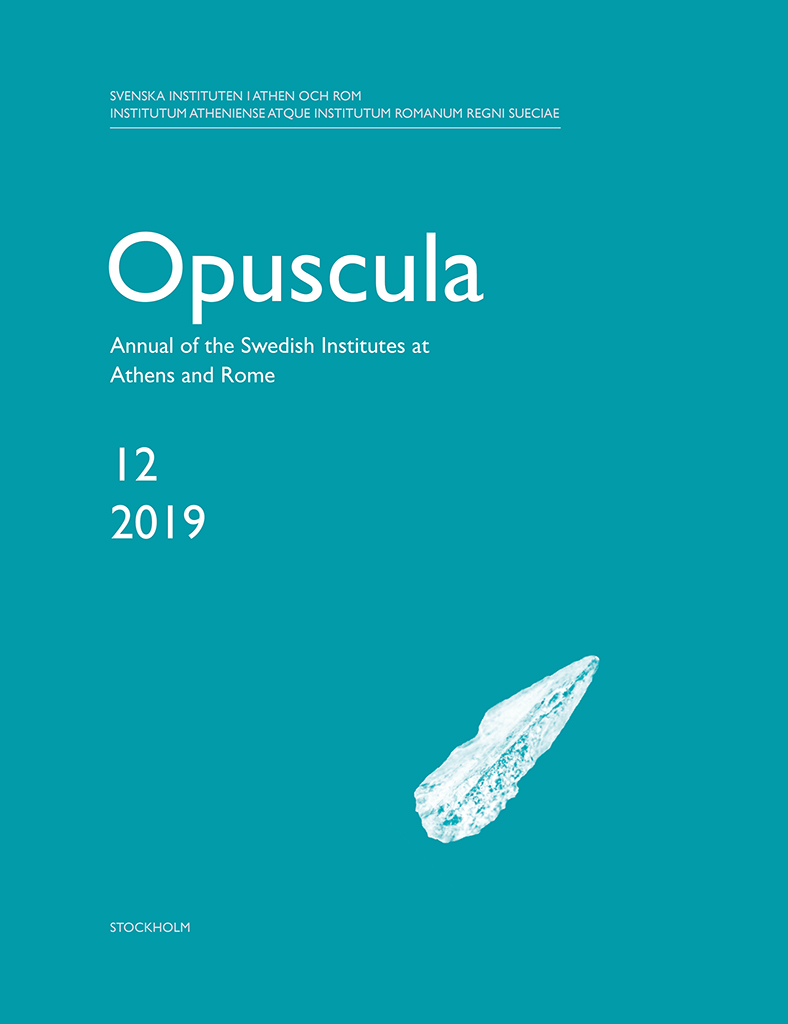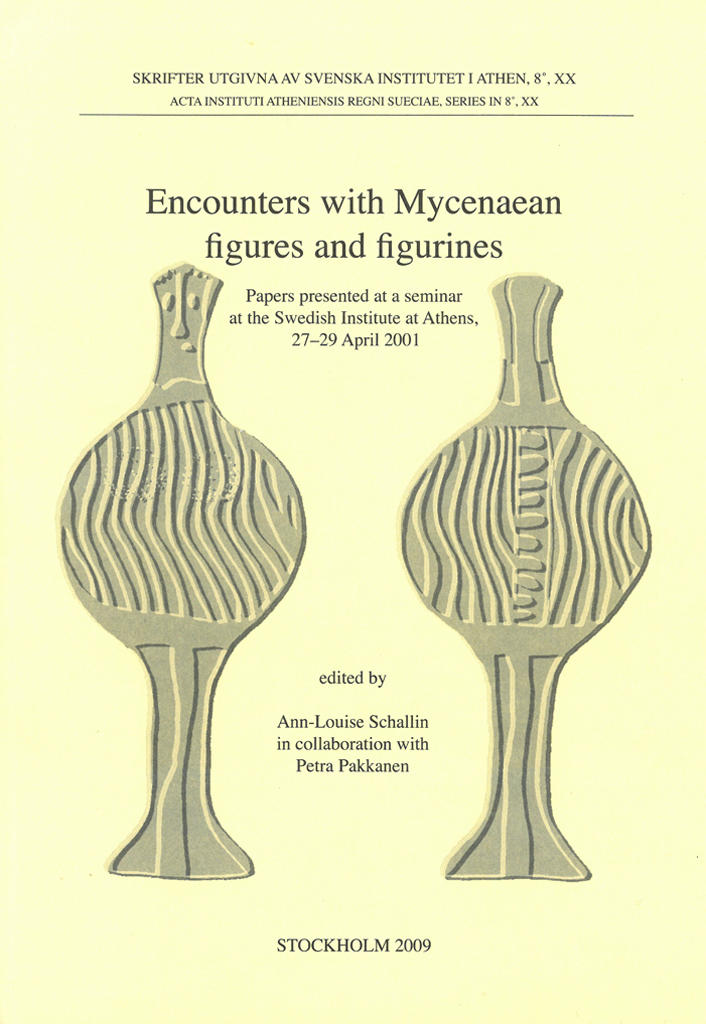Opuscula is published by the Swedish Institutes at Athens and Rome, with the aid of a grant from the Swedish Research Council. Distributed by Eddy.se AB. View journal at ERIH PLUS. All content available with open access. The New Swedish Cyprus Expedition 2019: Excavations at Hala Sultan Tekke (The Söderberg Expedition). Preliminary results, with contributions by L. Recht, B. Placiente Robedizo, C. Eriksson, L. Andersson, M. Svensson, L. Avial Chicharro, S. Hermon, M. Polig & D. Kofel By Peter M. Fischer (University of Gothenburg, Sweden) & Teresa Bürge (Austrian Academy of Sciences) Abstract The tenth season of excavations at the Late Bronze Age city of Hala Sultan Tekke was carried out in four areas: City Quarter 1 (CQ1), CQ4, City Wall 1 (CW1), and Area A (Tomb RR). The excavations in CQ1 provided additional information on the pre-LC IIIA occupation of the city. Stratum 3 which can be dated to the LC IIC (13th century BC) was further exposed. For the first time in the city even older phases, Strata 4 and 5, were found. These are tentatively dated to the LC I–II (15th to 14th century BC). In CQ4 numerous storage areas were exposed, which belong to a large…
Opuscula is published by the Swedish Institutes at Athens and Rome, with the aid of a grant from the Swedish Research Council. Distributed by Eddy.se AB. View journal at ERIH PLUS. All content available with open access. The New Swedish Cyprus Expedition 2018: Excavations at Hala Sultan Tekke (The Söderberg Expedition). Preliminary results, with contributions by J. Tracz and D. Kofel By Peter M. Fischer (University of Gothenburg, Sweden) & Teresa Bürge (Austrian Academy of Sciences, Austria) Abstract During the ninth field season at the Late Bronze Age city of Hala Sultan Tekke, excavations in City Quarter 1 (CQ1) continued and brought to light industrial and domestic structures belonging to three phases of occupation (Strata 3–1) dating to the 13th and 12th centuries BC (LC IIC–IIIA). Finds of more than half a ton of copper slag together with remains of furnaces and tuyères indicate intensive urban copper production. There is also evidence of textile production in CQ1. A magnetometer survey of roughly 23 ha resulted in the discovery of another large city quarter (CQ4) between CQ1 and Area A (the cemetery) with regularly arranged stone-built compounds of imposing dimensions intersected by streets. Several massive walls are faced with ashlar slabs…
Opuscula is published by the Swedish Institutes at Athens and Rome, with the aid of a grant from the Swedish Research Council. Distributed by Eddy.se AB. View journal at ERIH PLUS. All content available with open access. The New Swedish Cyprus Expedition 2017: Excavations at Hala Sultan Tekke (The Söderberg Expedition). Preliminary results By Peter M. Fischer (University of Gothenburg) & Teresa Bürge (Austrian Academy of Sciences). With contributions by Magda Ausiayevich, Bebelyn Placiente Robedizo, Victor Barrera Alarcón, Laerke Recht & Dominika Kofel. Abstract During the eighth field season at the Bronze Age city of Hala Sultan Tekke, excavations in City Quarter 1 (CQ1) exposed massive industrial and domestic structures belonging to three phases of occupation (Strata 3–1) dating to the 13th and 12th centuries BC (LC IIC–IIIA). Georadar survey, penetrating to a maximum depth of approximately 1 m, guided the excavation of walls of Strata 1–2, both of which were destroyed by conflagration. Excavations 1.5–2 m below the surface and also below the maximum penetration depth of the radar revealed a heretofore buried phase of occupation with substantial architectural units. For the first time, massive Stratum 3 structures with a markedly different building technique were exposed. Copper smelting installations,…
Opuscula is published by the Swedish Institutes at Athens and Rome, with the aid of a grant from the Swedish Research Council. Distributed by Eddy.se AB. View journal at ERIH PLUS. All content available with open access. The New Swedish Cyprus Expedition. Excavations at Hala Sultan Tekke (The Söderberg Expedition). Preliminary results By Peter M. Fischer & Teresa Bürge. With contributions by Laerke Recht, Dominika Kofel, David Kaniewski, Nick Marriner & Christophe Morhange Abstract In the seventh season at the Bronze Age city of Hala Sultan Tekke excavations continued in City Quarter 1 (CQ1) where georadar indicated stone structures to the south of the area excavated in 2010–2012. Massive domestic structures, which belong to three phases of occupation (Strata 1–3), were exposed. Both the most recent Stratum 1, and Stratum 2 were destroyed in a conflagration. The three phases are preliminarily dated to the 13th and 12th centuries BC. Excavations were also carried out in Area A, roughly 600 m to the south-east of CQ1. Seven circular anomalies indicated by our geomagnetic survey were excavated. Two were pits of modern date, and three were identified as Late Cypriot wells. Another anomaly turned out to represent a rich Late Cypriot offering…
Opuscula is published by the Swedish Institutes at Athens and Rome, with the aid of a grant from the Swedish Research Council. Distributed by Eddy.se AB. View journal at ERIH PLUS. All content available with open access. The New Swedish Cyprus Expedition 2015. Excavations at Hala Sultan Tekke. Preliminary results By Peter M. Fischer & Teresa Bürge. With a contribution by Dominika Kofel Abstract In 2015 the sixth season of the renewed excavations at the Bronze Age city of Hala Sultan Tekke continued in the compound which was exposed in Area 6W in 2013–2014. Further evidence of textile processing was found. The results of another ground-penetrating radar (GPR) survey in 2014 indicated a new city quarter west of the former. Excavations were initiated there in 2015 and parts of the remains of a large compound were exposed. Two occupational phases, Strata 1 and 2, could be determined, both of which were destroyed in a conflagration. Further excavations were carried out in Area A, 550 m to the east of Area 6W and close to the mosque of Hala Sultan Tekke. In 2014 more than 80 circular anomalies were indicated by our geomagnetic survey supported by GPR. Twelve of them were…
Opuscula is published by the Swedish Institutes at Athens and Rome, with the aid of a grant from the Swedish Research Council. Distributed by Eddy.se AB. View journal at ERIH PLUS. All content available with open access. The Swedish Jordan Expedition 2013 at Tall Abu al-Kharaz. Preliminary results from Areas 9, 10 and 11 By Peter M. Fischer & Teresa Bürge Abstract The Swedish excavations at Tall Abu al-Kharaz, a twelve-hectare tell in the central Jordan Valley, continued in 2013 in order to shed further light on the Iron Age occupation of this city that was first settled around 3200 BC, corresponding to the conventional Early Bronze Age IB. The Iron Age occupation lasted from the 12th century BC until 732 BC, when the city was conquered by the Neo-Assyrians. From 2009 to 2012, excavations in Area 9 revealed an exceptionally well-preserved two-storey compound dating from Iron Age I (local Phase IX), i.e. around 1100 BC. The stone compound was exposed for a length of 46 m. It consists of 21 rooms, with walls still standing to a height of more than 2 m. Several hundred complete vessels and other objects point to the extensive contacts of a fairly rich…
Published by the Swedish Institute at Athens. Distributed by Eddy.se AB. Encounters with Mycenaean figures and figurines. Papers presented at a seminar at the Swedish Institute at Athens, 27–29 April 2001 Edited by Ann-Louise Schallin & Petra Pakkanen Abstract This volume presents fourteen articles which discuss Mycenaean figurines from various points of view. They focus on different aspects of the figurines, elaborating on their function, contextual characteristics, production, use-life, classification, topography, and history of scholarship. The articles are based on papers given at a workshop at the Swedish Institute at Athens in April 2001 entitled ‘Cultic Space and Mycenaean Figurines’. The idea of having a workshop arose from the fact that several of the participants were involved at the time with the documentation of various figurine types from the so-called Potter’s Workshop at Mastos in the Berbati Valley in the Argolid. The number and variety of the Mycenaean figurines from Mastos is impressive, particularly as the excavation had covered only a small area. The excavator, Å. Åkerström, proposed that the site had a cultic function in addition to its role as a production centre. In order to better understand the characteristics and identity of Mastos, scholars were invited to discuss…
Published by the Swedish Institute at Athens. Distributed by Astrom Editions. Celebrations of death and divinity in the Bronze Age Argolid. Proceedings of the Sixth International Symposium at the Swedish Institute at Athens, 11–13 June, 1988 Edited by Robin Hägg & Gullög C. Nordquist Abstract Twenty-four papers on various aspects of burial customs and religious cult practice in the region Argolis (Greece) during the Bronze Age, read at an international conference in Athens; the papers are followed by transcripts of the discussions of the symposium. The papers are arranged in six groups, discussing (1) ceremonial practices in the Early and Middle Helladic periods, (2) mortuary customs, state formation and Mycenaean society, (3) burial rites in tumuli, tholoi and chamber tombs, (4) symbols and symbolism in Mycenaean celebrations, (5) Mycenaean cults and cult practices, and (6) religious aspects of the post-Bronze-Age period. Contents Preface (p. 7) Ceremonial practices in the Early and Middle Helladic periods Daniel J. Pullen, ‘Early Helladic burials at Asine and Early Bronze Age mortuary practices’, pp. 9–12 Miriam Caskey, ‘Thoughts on Early Bronze Age hearths’, pp. 13–21 Carol Zerner, ‘Ceramics and ceremony: Pottery and burials from Lerna in the Middle and early Late Bronze Ages’, pp. 23–34…








